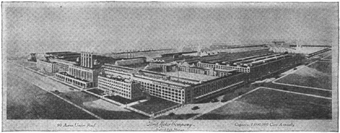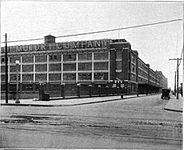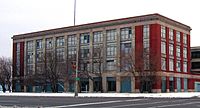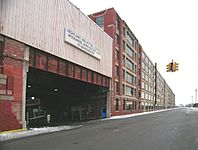Highland Park Ford Plant facts for kids
|
Highland Park Ford Plant
|
|

The Highland Park plant in 1922
|
|
| Lua error in Module:Location_map at line 420: attempt to index field 'wikibase' (a nil value). | |
| Location | 91 Manchester Avenue at Woodward Highland Park, Michigan |
|---|---|
| Built | 1910 |
| Architect | Albert Kahn; Edward Gray |
| NRHP reference No. | 73000961 |
Quick facts for kids Significant dates |
|
| Added to NRHP | February 6, 1973 |
| Designated NHL | June 2, 1978 |
The Highland Park Ford Plant is a famous old factory in Highland Park, Michigan. It was built by the Ford Motor Company. This factory was special because it was the first place in the world to use a moving assembly line to build cars. This new way of building cars changed how things were made forever! The plant became a National Historic Landmark in 1978, which means it's a very important historical place.
Contents
History of the Ford Plant
The Highland Park Ford Plant was designed by Albert Kahn in 1908. It opened its doors in 1910. Before this, Ford made its first Model T cars at a different factory. The Highland Park plant was much bigger.
A Huge Factory for Its Time
This huge complex included offices, factories, a power plant, and even a metal foundry. This was part of Ford's plan to own every step of making a car, from raw materials to the finished product. This idea is called vertical integration. At 102 acres, the Highland Park Plant was the largest factory in the world when it opened. Its large and smart design set a new standard for factories built after it.
The Moving Assembly Line
On October 7, 1913, something amazing happened at this plant. It became the first car factory in the world to use a moving assembly line. This meant that instead of workers moving around the car, the car moved along a line. Each worker did one small task as the car passed by. This idea is called division of labor.
This new method made building cars much faster. It used to take 728 minutes to build a Model T. With the assembly line, it took only 93 minutes! This speed helped Ford lower the price of the Model T from $700 in 1910 to just $350 in 1917. This made cars affordable for many more families.
Ford's Five-Dollar Day
On January 5, 1914, Henry Ford made another big change. He announced that factory wages would increase from $2.34 to $5.00 per day. He also cut daily shifts from nine hours to eight. This was a huge pay raise, almost three times what other factories paid.
This big pay increase helped Ford keep his workers. The number of workers leaving their jobs dropped a lot. This showed that paying workers well could be good for business.
Later Years and New Uses
In the late 1920s, the Model T became less popular. Ford moved car assembly to a newer, bigger factory called the River Rouge Plant in Dearborn. The Highland Park plant then focused on making car parts and Fordson tractors.
During World War II, the factory helped the war effort. Ford built 1,690 M4A3 Sherman tanks at this plant between 1942 and 1943. After the war, it continued to make tractors until the 1990s.
By 2011, Ford Motor Company used parts of the plant to store documents and old artifacts for the Henry Ford Museum. A clothing store called Forman Mills also opened in a section of the plant in 2006.
Current Status of the Plant
Today, a group called the Woodward Avenue Action Association is working to save parts of the historic plant. They plan to buy two buildings: an administration building and an executive garage. They want to create a center there with videos, displays about car history, and a gift shop. This center could also be a starting point for historical car tours.
In the Media
The Highland Park Ford Plant was used as a filming location for the 2011 Disney movie Real Steel.
Gallery
See also
 In Spanish: Planta Ford de Highland Park para niños
In Spanish: Planta Ford de Highland Park para niños






